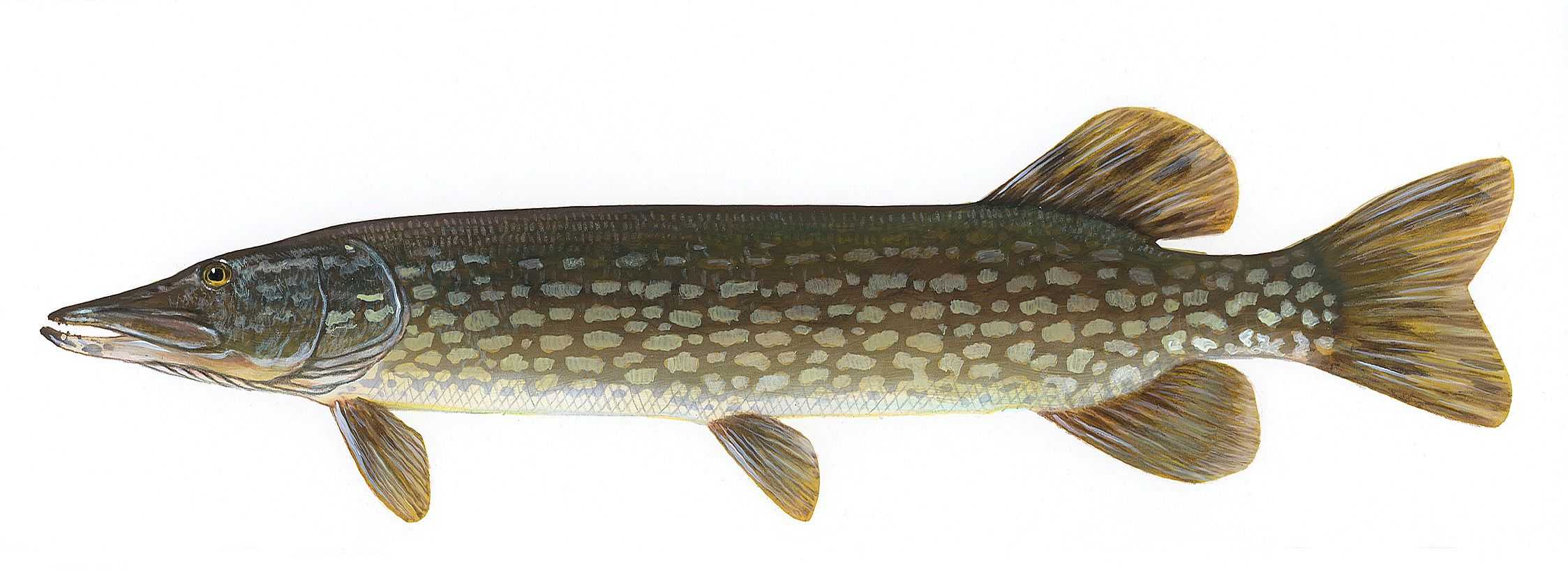Northern Pike

Species Details
Esox Lucius
Esocidae
Esociformes
Onshore
2 - 34 lbs.
16" - 29"
To successfully catch Northern Pike, what techniques and tips should I follow?
Northern Pike can be caught using large, flashy lures like topwater lures, spoons, and swimbaits. Target weedy areas, shallow bays, and drop-offs. Use a wire leader to prevent bite-offs. Patience and persistence are key.
Northern Pike (Esox lucius) Fish Description
The Northern Pike (Esox Lucius) is a popular freshwater gamefish known for its greedy carnivorous nature. They have an elongated body and a grey to greenish color that fades to a yellowish-white belly. They have distinctive uneven rows of yellowish to white specks that run across its body.
Diet
Northern Pike is an aggressive hunter and not very picky about their food, eating just about anything that comes their way. They prey on other fish, including golden shiners, yellow perch, bluegills, suckers, and even other Northern Pikes. Larger ones have also been known to snatch small waterfowls, frogs, and rodents with their large mouth lined with sharp teeth when these unknowing victims are swimming on the surface or if they get too close to the edge of the water.
Spawning
Northern Pike have a short spawning season, March-April. Since the adults are solitary and highly territorial, they will leave their area and travel inshore or upstream to spawning areas in early spring. Spawning normally occurs during day in shallow, quiet areas with a vegatated bottom. They leave their eggs once they are laid.
Interesting Facts
- They are solitary predators.
- They are mostly territorial.
- The oldest pike on record is 25 years old.
- They are also referred to as freshwater sharks.
- They can lie still for long periods of time.
Northern Pike Speed and Average Size
Northern Pikes are strong swimmers, but they are not actually known for their speed as they can only swim at an average of eight to ten miles per hour. It may not be as fast as other species; it has, however, the ability to sudden high-energy starts that they use for ambushing preys or for escaping life-threatening situations.
The average Northern Pike is 2 feet long and 34 pounds. The largest pike ever caught in the U.S. was reportedly 4 feet 10 inches.
Distribution and Habitat
As the name suggests, Northern Pikes are mostly found throughout the northern half of North America, with a higher population in the Great Lakes, northern New England, eastern New York, Minnesota, and the Ohio Valley. You can also find them in Nebraska and Missouri and as far north as Alaska and Canada.
They live in cool, shallow areas of streams, lakes, and rivers where they have good access to their food. However, in the summer, when waters heat up, they head to the deeper, cooler waters.
Fishing Techniques - How to Catch Northern Pike
A Northern Pike catch can be very rewarding as it’s known to be a tough fighter. You should remember to keep your distance from its mouth as its dagger-like teeth can cause significant damage to anything it can clamp down on.
With its aggressive nature and its strong swimming ability to boot, catching Northern Pike can be a daunting challenge. A 7-foot, medium-action rod paired with a regular spinning reel with a drag system that can stand a maximum of at least 15 pounds is more than enough to handle this fish. Equip your rod and reel with a more durable 15 to 20-pound braided line at the minimum so that the chances of the Pike’s sharp teeth breaking the line will be decreased.
Because these fish are known to be voracious eaters, various lures such as soft plastic swim-baits, inline spinners, and spoons can easily attract the fish. Just make sure to reel in at a slow, consistent speed so that your lure would look like an injured fish. Also, Northern Pikes are known to play with their food, so when you feel a strong tug on your line, don’t reel it in too fast. Just keep reeling at a slow pace and wait patiently for the Pike to strike again.
The ideal place to cast your line out are inlets, bays, coves, and drop-offs that have shallow, marshy areas with an abundance of weeds, as these are where Northern Pikes usually hunt for food.







